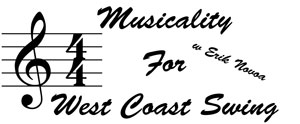The West Coast Swing class in Connecticut just completed a month (four 1-hour classes) studying musicality. As I explained to the class on week 1, everything that I was teaching would be compressed information. This meant that every class I taught ideally would have been experienced in double the time: 1 hour of musical theory, and 1 hour of dance application. Because this weekly class is only 1 hour long, dancing took precedent.
How Much Musicality in 1 Month
Over the course of 4 weeks, we explored may aspects of Musicality for West Coast Swing. We began with basic understanding of music such as the definition of a beat and a measure. We then expanded that knowledge to show how not all beats are created equal which begins to create the sense of pulsed timing and starts to give Swing dancing its feel. We then discussed musical composition and incorporated 2-beat extensions to "feel" the hyper-measure of the lyrical phrase. By week 3, we examined how the 6-beat basic patterns of West Coast Swing are overlayed upon the 8-beat phrase and challenged dancers to accent "1" of the phrase using the syncopations that they had learned the month prior. Our last week of the month focused on "hitting the breaks" with one move that could be extended.
Tip Of The Musicality "Iceberg"
We covered a lot of information in our West Coast Swing Musicality classes in Connecticut. I was very excited when students attempted to complete a minor homework assignment of "mapping" two songs, but that is only the tip of the "iceberg". Musicality is an enormous aspect of West Coast Swing. There is a great distance between defining a beat and understanding jazz rhythmic-timing. There is even a greater distance to consciously, manipulating your dance to fit the compositional phrasing, accents, and lyrics of a song, while staying with a West Coast Swing framework.
Is It Better To Study Musicality
Although it feels wonderful to dance for fun, there is something incredible about understanding how music shapes a dance, and how one can shape their dance to the music. Learning musicality through the study of music could seem boring to the neophyte, learning musicality not only helps dancers appreciate the dance even more, it helps them examine how they can become better dancers in West Coast Swing and every other dance they'll ever learn. Best of all, it increases their appreciation of music in a way that transforms their lives.
As a teacher, I find that there are two moments that make it all worth while: when a student enjoys their first, full social-dance and when their eyes pop while learning about musical composition. I enjoy being the teacher that opens 2 windows, one to dance and the other to music.
If you attended the class, please let me know what was your favorite part.
If you haven't experienced this class but want to, please let me know and I'll put it on our schedule again.


